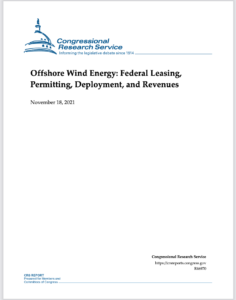Full Title: Offshore Wind Energy: Federal Leasing, Permitting, Deployment, and Revenues
Author(s): Laura B. Comay, Corrie E. Clark
Publisher(s): Congressional Research Service (CRS)
Publication Date: November 18, 2021
Full Text: Download Resource
Description (excerpt):
Offshore wind continues to be of interest as a potentially significant renewable energy resource for the United States. Offshore wind power relies on turbines constructed in bodies of water, which use wind to generate electricity. According to some estimates, offshore regions of the contiguous United States and Hawaii have the net technical potential to generate more than 7,000 terawatt hours per year of wind–based electricity—nearly twice the amount of electricity used annually in the United States in recent years—although these estimates do not take into account considerations of economic feasibility. The Biden Administration has announced a government–wide effort to deploy 30 gigawatts of offshore wind energy by 2030, which would be equivalent to more than 2% of the U.S. utility–scale electricity generating capacity and approximately 25% of total U.S. wind electricity generating capacity.
